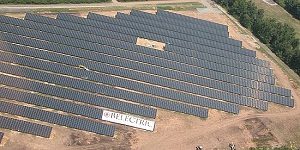Week in review: Solar ripens as end of summer approaches
 As summer winds down in the northern hemisphere the solar industry remains poised to expand like farmers expecting a higher yield. New reports show that the industry is poised for continual growth over the next few years. But the global industry is still facing threats that include anti-competitive issues across the world even as new applications and markets pop up.
As summer winds down in the northern hemisphere the solar industry remains poised to expand like farmers expecting a higher yield. New reports show that the industry is poised for continual growth over the next few years. But the global industry is still facing threats that include anti-competitive issues across the world even as new applications and markets pop up.
Across the globe, the solar industry is poised for continual growth through at least 2015. A new TechNavio report, for instance, anticipates that solar will grow by 15.3 percent annually over the next few years. The report: “Global Solar Panels Market 2011-2015” found that many trends in solar, including price drops, will continue over the period, which will help keep the industry growing. It also found that solar will continue to diversify into new markets and employ more technologies, like concentrating PV.
The promise of organic PV (OPV) is among one of the more promising technologies to further reduce the cost of solar. But large-scale commercial applications are still a ways off. Solarmer worked with Phillips 66 and South China University of Technology (SCUT) to develop the breakthrough champion cells, which reached record-breaking efficiency levels of 9.3 percent. That’s far less than silicon modules which are reaching efficiency levels higher than 20 percent, but the cost of making OPV can be much less, making them a tantalizing solution that could be used in building-integrated PV and more.
Meanwhile Envision Solar is working to control the costs of its Solar Tree parking/shading PV structures. It’s now offering pre-casting and shipping of the concrete columns to support the structures. By pre-casting the structures, the company avoids a lot of costs associated with pouring concrete onsite, which include weather, local labor costs and others. It also allows the installers to avoid time waited for the pilings to cure. Both help reduce the time and non-PV costs of installing solar.
Speaking of new markets, there’s been a big uptick in China non-residential, onsite PV installations. NDP Solarbuzz’ latest “China Deal Tracker” found that the number of new, non-residential building-mounted PV applications has soared to more than 700. The report researched more than 1,000 current applications in China for solar projects larger than 50 kilowatts. It also found that commercial installations will outpace utility installations in 2012. The increase in solar installations could be a welcome thing for the worldwide solar industry by increasing demand for modules, helping to reduce the pressure for cost drops.
The cost of solar incentives at all levels remains contentious among countries. China, the U.S. and Europe are fighting over incentives for solar from manufacturing incentives to subsidies for installing solar. Most recently China’s Commerce Ministry found that by including local-content provisions at the state level, the U.S. violated World Trade Organization (WTO) rules. It could lead to WTO actions against U.S. solar and wind manufacturers.
Even in the U.S. new markets are showing growth. Case in point, Indiana. The state isn’t known for solar incentives, but is offering a feed-in tariff (FiT). To take advantage of the program Sunrise Energy Ventures will build three 10 megawatts PV arrays to support Indianapolis Power & Light’s grid around the Indianapolis region. The arrays will be the largest in the midwest U.S.
Established markets like Colorado remain hungry for more solar, too. For instance, Xcel Energy’s Solar Rewards program recently offered a longly anticipated, new incentive program to support solar garden development in the Centennial State. It was fully subscribed within half an hour of being released. The incentive program, at 4.5 megawatts, is relatively small, but is the first of a series of solar garden incentives the utility will offer over the next year or two.



